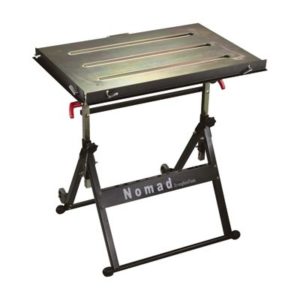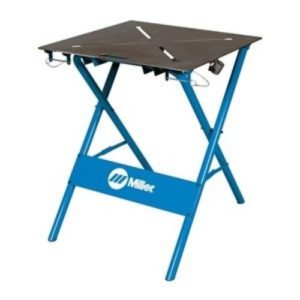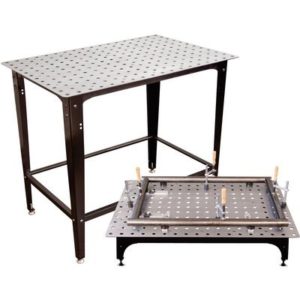[thrive_headline_focus title=”What is spot welding?” orientation=”center”]
Spot welding specifically involves heat generating directly at the interface utilizing the joint’s electrical resistance. This process joins two metal surfaces by relying on heat from the metal’s resistance to the flow of electric current, without the utilization of an arc. This process is also considered a form of resistance welding.
In the spot welding process, two sharp copper alloy electrodes are used to deliver a small current to a specific sight, while it fastens the workpieces simultaneously. This creates a noticeable current between the two pieces, eventually melting them for the welding process. The great part is that it’s a very quick process, only 10 milliseconds, not enough time to cause warping.
What should I look for when purchasing a spot welder?
Because a spot welder is so versatile, there is no need for component preparation.
When looking for the right spot welder, you will notice the market is well saturated. This can create some confusion for even the best of welders or metal fabricators. There is a wide range of prices, which again can be confusing, as some higher priced spot welders appear similar to those at lower prices.
Welding units come in the conventional air-cooled to industrial liquid cooled.
Make sure you purchase the correct welding gun
Do yourself a favor and don’t make a costly mistake by buying the wrong type of spot welding gun.
Using an improper unit can create a rupture in the fused area and create a tear off of the base metal flanking the weld. The correct spot welder for your specific needs are dependent on factors such as enabled duty cold by the unit, output needed, amount of welding you plan to do, and last, power supply.
Explore, your specific needs. Consider the types of metals you will be welding. A resistance spot welder is the preferred tool for welding metals such as galvanized steel, titanium, stainless steel, low carbon steel, and copper. This type of unit can weld clean, mild cold rolled steel sheet, wire mesh, and sheet metal. A key thought is some models can weld any type of metal, however, a few metals are welded by a specific spot welder.
You should consider the thickness of the metal or project to be welded. This is a very important step and factor when selecting the proper spot welder. All metals possess a different level of thickness, which can determine what power requirements a specific welder needs.
[thrive_text_block color=”red” headline=”Detailed Comparison And Buyer Guide”] [/thrive_text_block]
| Product Name | Customer Reviews | Editor Rating |
|---|---|---|
 | 3.4 /5 Stars | |
 | 3.1 / 5 Stars | |
 | 3.0 /5 Stars | |
 | 3.2 /5 Stars |
Other things to consider when spot welding
Consider the type of material, the thickness, and the components shape prior to making your decision.
Also the need for single or multiple applications tools, which can help you buy an affordable welder in case you do not need it for multiple applications. Keep in mind, each type of welder is designed with a specific use in mind.
There are a variety of spot welders to consider depending on your work. A stationary single spot welding unit is not considered portable and come in 2 different types; rocker arm or horn and press.
About the Horn Units
The horn units have a rocking or pivoted upper electrode arm activated by pneumatic or operators physical power. The rocking motion of the arm applies pressure today and left the upper electrode up-and-down the stationary electrode is mounted on a pivot arm which is then brought up and down onto the workpiece by the manual or pneumatic method.
This type is more affordable and easier to use but is limited to task not more than 50 kg volt amps it’s also great for metals having a high gauge and other words then metals for bigger jobs requiring more than 50 kg volt amps depressed type unit is the preference in this unit the upper electrode shifts in a straight line along the machine, motion in the pressure are given on the upper electrode by pneumatic or hydraulic means or by motor. These units have side position electrodes for giving you several wells in a short time.
[thrive_text_block color=”red” headline=”About Press Spot Welders”] [/thrive_text_block]
Press spot welders are usually the preferred in metalworking work areas due to their versatility and easy obtainable throat depth choice and transformer capabilities with required electrode forces. If you require a more portable unit a single spot welding machine should fit your needs. Smaller, and with a more compact design, they can be corded or cordless.
Spot gun machines: a number of welding guns are used to work with Spot welders and are designed to work with larger pieces. These units are also portable and are connected to transformers using a long cable, then moved to where the welding is taking place. The electrodes generate a contact area that renders the current density via the workpieces. In this type of welding gun, the welding pressure is delivered hydraulically, pneumatically, or manually, depending on the spot guns size and shape.
Multiple spot welding machines: The name says it all. These units are good for high-volume jobs, as in the automotive industry. They are available as press units in which separate guns hauling electrode tips are placed. To keep all electrodes from holding the current, sells are created sequentially. This equipment is relatively affordable and simple for flexible units.
Seam Spot Welding Machines: These units function with the help of sophisticated control technique featuring a travel speed as well as the current flow’s sequence to retain overlapping welds. The actual routine, welding tempo, and spots every centimeter are interdependent.
Spot Welding Machines: These units function with the help of sophisticated control technique featuring a travel speed as well as the current flow’s sequence to retain overlapping welds. The actual routine, welding tempo, and spots every centimeter are interdependent.
Bench spot welding machine: These are very versatile units and often used in production and workshop settings. They have a top quality welded steel body that occupies a minimum bench space. The top arm extension is combined with the frame, and the secondary sum at the bottom may have some tooling.
[thrive_text_block color=”red” headline=”Materials to be Welded”] [/thrive_text_block]
Steel
Low carbon steel is ideal for spot welding. Alloy steels and higher carbon steel result in hard welds that are prone to crack. However, tempering can bring these risks down. You can even spot weld austenitic stainless steels having the 300 series grade along with ferritic stainless sheets. However, the harder martensitic stainless steels are not apt for spot welding.
Aluminum
Aluminum is suitable for welding through a high power and neat oxide-free surface. You need to clean the surface which increases your cost. You can not spot weld dissimilar items due to different thermal conductivity points and melting properties. Chrome and nickel plated steels are simple to spot weld, although zinc, tin, and aluminum require an elite preparation, as is the case of coating metals.
Spot welding is specifically for joining metals having a thickness of up to 3 mm (0.125in).
Due to the high rate of production, a spot welder is bound to increase the productivity at a workplace as well as restore a metallic tool or vehicle to its healthy state before a mishap. One of the major applications of such a unit is in the industry of automobiles, wherein metallic sheets are used for making the body of cars. Other applications of spot welding include in designing stuff such as batteries, nuts and bolts, metal buckets, and batteries.
There are many spot welders for professionals, hobbyists, and several industrial applications. The biggest advantages of using spot welders are high speed, dimensional accuracy, adaptability for automation in highly productive tasks, and economical range.
[thrive_text_block color=”red” headline=”Choosing the Best Spot Welder: The Buying Factors”] [/thrive_text_block]
A spot welder is a versatile tool and does not need any kind of component preparation. However, the market is flooded with different spot welders and selecting the right one can be a bit confusing even for a somewhat experienced welder or metal fabricator. This is perhaps because of the price differences that are at times tough to comprehend as well as justify. The welding units are available from conventional air cooled to industrial liquid cooled ones.
Choosing the wrong spot welder can actually prove to a costly affair. With such a unit, instead of a proper spot weld, you will encounter a rupture in the fused zone along with a tear of the base metal flanking the weld. Selecting the right spot welder is actually dependent upon several factors such as the enabled duty cycle by the unit, output required, extent of welding that you wish to do, and power supply. Let’s explore all such influential factors.
[thrive_text_block color=”red” headline=”Your Major Requirements”] [/thrive_text_block]
Well, you should start by knowing your key needs without which you seriously cannot choose the right model with the required features. Following is what you need to find out or consider, even before finding out about the different spot welding units.
A list of metals that you will be spot welding
A resistance spot welder is preferred for welding metals such as galvanized steel, low carbon steel, stainless steel, titanium, and copper. Such a unit can weld clean mild cold rolled steel sheet, wire mesh, stainless steel sheet, and plates for tubing, nuts, studs, and bolts. A few models can weld any kind of metal but a few metals are welded by using a specific spot welder.
Consideration of thickness of the metal or product that is to be welded
This is a vital factor for selecting a welder. All metals possess a different level of thicknesses due to which power requirements differ due to which using a special welder might be indispensable. The required weld current, which depends on the type of material to be welded, its thickness, and component’s shape. The need for single or multiple applications of the tool, which can help you choose a more affordable spot welder in case you do not need it for a variety of applications.
In short, you should know the primary purpose for using the welder, which can be automotive, heavy production, fabrication, and farm-based. This is because each type of welder is designed for some specific use.
Electrode Material and Geometry
Electrodes are a critical factor to consider for best resistance welding process although they are the most abused ones. In fact, you need to consider their material, cooling power, tip profile, shape, and size. Technically, the shape and size of individual welds depend heavily upon the shape and size of the electrodes. Electrodes tend to differ in terms of electrode geometry or shape and consequently in terms of function. For example, the right electrode boosts the electrical, mechanical, and thermal performance due to the increase in the cross-sectional area from the workpiece.
Even the electrode contact area’s diameter has a role to play. If it is too small, it gives shorter welds with inadequate strength. Similarly, if it is too large, you get unstable as well as inconsistent welds. In short, the electrodes should conduct current to the metal piece, constrain it, and conduct heat from the piece. To ensure all these three functions, it is essential to choose the right electrode material.
The electrode material needs to maintain high loads at elevated temperatures as well as retain sufficient thermal as well as electrical conductivity. A variety of refractory- and copper-based materials are suggested, as per the application. Resistance Welding Manufacturers Association (RWMA) has prescribed materials for electrodes and has split into three groups or classes:
Group A: Includes copper alloys and is split into two classes. Class 1 includes materials made using 1% cadmium and 99% copper and is recommended due to great electrical and thermal conductivity. These alloys are suitable for spot welding bronze, brass, magnesium alloys, and aluminum alloys. Class 2 includes 0.8% chromium and 99.2% copper. These materials are general purpose ones and are suitable for production seam and spot welding of maximum metals.
Group B: Includes refractory metals as well as metal composites.
Group C: Includes special materials.
Conductive materials such as copper and dispersion strengthened copper (specialty material) are ideal for resistive metals such as stainless steel and nickel. These higher conductivity alloys are beneficial while welding coated steels because the ensure less heating due to low contact resistance. On the other hand, resistive materials such as molybdenum are for welding conductive stuff such as copper and gold.
Described by International Organization for Standardization – ISO 5182, electrode materials can vary. Mostly, copper alloys are used for boosting hardness as well as retaining good conductivity. Some of the commonly used materials belong to Class 2, which are copper with chromium or zirconium. They are preferable for high strength and low carbon steels to be welded.
For spot welding, harder sheets such as stainless steels, lower welding current but higher electrode forces are needed. Thus, they are better welded with the harder electrode materials belonging to Class 3, such as an alloy of silicon, copper, and nickel. Refractory materials, such as molybdenum, tungsten, and tungsten with copper, are ideal for projection welding inserts. This is because the electrode contact area is thrice of that the weld size and that the materials feature more hardness and lower conductivity than those of Class 2. However, these are not meant for spot welding because they localized heat at the contact’s tip that can invite electrode’s cracking. The exception is for using them for high conductivity metals, where the heat comes from within the electrode tip and conducted into the metals to be joined.
[thrive_text_block color=”red” headline=”RWMA Recommendations”] [/thrive_text_block]
Following these recommendations is essential for choosing the right welder. The RWMA have committed to improving industry standards for more than 50 years. At present, it represents around 40 manufacturers selling resistance welders, components such as controls and transformers, and electrodes.
Performance Measures
Any spot welder is rated in its thermal rating measured at KVA. The RWMA rates it by considering a 50% duty cycle for standard units. Nevertheless, not all manufacturers meet these standards. So, you need to check that out. Short-circuit current of the unit is another performance measure to check out. RWMA states this current as per the unit’s size, throat dimensions, KVA rating, and permissible duty cycle under short-circuited situations.
For adhering to this standard, a spot welder should possess sufficient copper areas in the secondary loop, KVA rating as per 50% duty cycle, and sophisticated water cooling system. You should also consider the weld force, which contributes to the overall strength of the weld. Most modern welders are run with air cylinders of different diameters, which apply the force via a lever mechanism (rocker arm) or directly (press). The press-type unit’s force is calculated from the cylinder’s diameter as well as from the applied air pressure.
In case of a rocker arm unit, extending the length (throat deep) of the arm affects the maximum welding force, as the latter decreases proportionately as the throat depth increases. RWMA states the maximum force to gain from both these types or from the frame size of the unit.
Lastly, you also need to consider the durability and the frequency of using the welding machine. You can discuss this with the manufacturer who can accordingly aid you in choosing the right spot welder.
[thrive_text_block color=”red” headline=”Spot Welder Reviews Below”] [/thrive_text_block]
Electrode Electric Spot Welder Welding (30 Rated Duty)
This unit is designed for home jobs. You can rely on it for spot welding up to 16 gauge steel, over 1 mm rails into AK47 receivers of 1 mm, and 2mm thick sheet metal. Consider it if you need a spot welder to operate from a typical 115VAC circuit within 15A. Except for power switch and insulators, all parts are metal, which indicates a fairly solid metallic build. The four copper tongs are also solid and thick and have a length through which the tips can reach around 7.5 inches into a piece. The unit has two sets of tips, which are readily available. This unit is for welding two metallic pieces each up to 1mm thick, which means it is not for 1/16′′ thick sheet metal. You can consider using thinner sheets for welding, of plain, stainless, or galvanized steel or even of tin.
[thrive_link color=’red’ link=’https://amzn.to/2KlPboS’ target=’_self’ size=’medium’ align=”]Click here to see the lowest price for the Electrode Electric Spot Welder Welding (30 Rated Duty)[/thrive_link]
Chicago 120-Volt Portable Air-Cooled Spot Welder
This one is ideal for a hobby type people and individuals performing little jobs. The unit is perfect for welding nickel terminals of high temperature to the nickel-based wire. You can even use it with uncoated stainless, galvanized, or mild steel sheet. The unit is portable enough to carry it easily anywhere. It features six tongs with standard tips, locking firmly onto the workpieces.
[thrive_link color=’red’ link=’https://amzn.to/2OU2Vrx’ target=’_self’ size=’medium’ align=”]Click here to see the lowest price for the Chicago 120-Volt Portable Air-Cooled Spot Welder[/thrive_link]
Pulse Sparkle Spot Welding Machine 200W Welder
This is a small-scale welder dedicated to making jewelry. It is not for those who have no experience in welding but for those who have can use it easily. The unit can weld alloys of precious metal such as Titan, Palladium, Silver, Gold, Tungsten, Platinum, and high-grade Steel. It can even weld most brass alloys, tin, and aluminum with some limitations along with alloys having differing properties. You can make thousands of welds without any issues. Because it is a gas-less pulse welder, avoid using it on precious stuff such as gold if you do not know about how to use the welder on them. It is easy to weld 1.6mm stainless steel with this unit. Consider it for welding for purely ascetic purpose or on less significant objects, as the chain is strong even at 1/4 weld pen. While welding 1.0mm stuff on max setting, a single weld can give you 100% weld pen.
[thrive_link color=’red’ link=’https://amzn.to/2DRJbnx’ target=’_self’ size=’medium’ align=”]Click here to see the lowest price for the Pulse Sparkle Spot Welding Machine 200W Welder[/thrive_link]
US. Solid Handheld Spot Welder Machine
This one is another spot welder dedicated for precision welding of batteries of laptop and mobile phones. You only need to hold the battery and raise it up to one of the welding needle butts at the right spot. Each needle applies reliable pressure, as it is regulated independently. The welding current is quite stable for offering a clean spot with smaller sparks but without blackening. There is also no moisture emission in the case of lithium models. The unit comes with a single chip microcomputer that enables dual pulse welding. Further, the LED controls make it easy to set up several parameters accurately. You can use this welder for welding high-grade batteries such as lithium, nickel-hydrogen, and nickel-cadmium.
[thrive_link color=’red’ link=’https://amzn.to/2S5SGSL’ target=’_self’ size=’medium’ align=”]Click here to see the lowest price for the US. Solid Handheld Spot Welder Machine[/thrive_link]
Accessories
Battery Pack:
This lighter unit is dedicated to hold spot weld batteries as well as recharge them. The charging function is reliable, which can recharge any voltage batteries for mobile gadgets. While the instructions are no obvious, it takes no time to get used to this unit. The welder cannot be beaten in terms of price and functionality. It comes with achieved precise micro-computer, MCU start control, wider current range ability, single/double pulse soldering modes, digital battery recharge function, touch digital control, short circuit protection, and temperature display with accurate spot soldering.
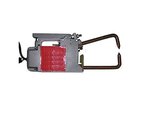
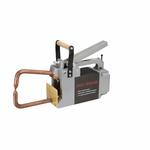
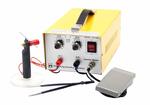





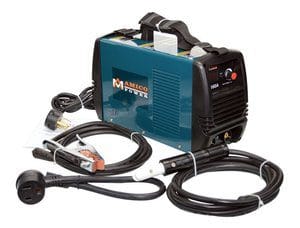
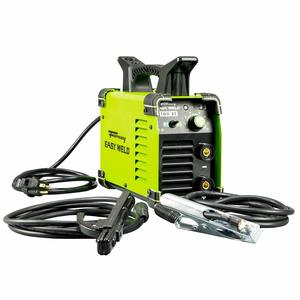
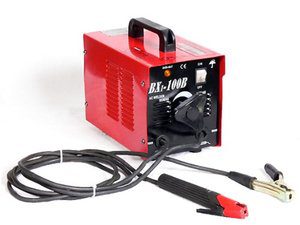
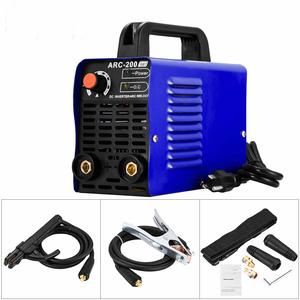






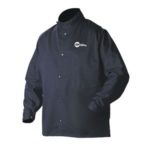
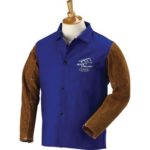
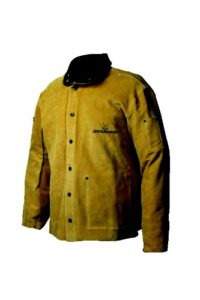
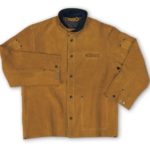
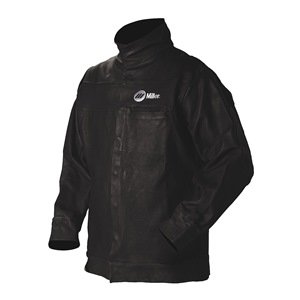




 The 9100 FX SpeedGlas welding helmet by 3M is probably the best SpeedGlas helmet, featuring all the bells and whistles in a compact package. For starters, it features an auto-darkening filter which activates itself with 0.1 milliseconds of detecting flashes of welds. The viewing area has the dimensions of 2.1 inches in length with 4.2 inches in width, which gives a clear view on the welding work being done without causing any damage to the eyes.
The 9100 FX SpeedGlas welding helmet by 3M is probably the best SpeedGlas helmet, featuring all the bells and whistles in a compact package. For starters, it features an auto-darkening filter which activates itself with 0.1 milliseconds of detecting flashes of welds. The viewing area has the dimensions of 2.1 inches in length with 4.2 inches in width, which gives a clear view on the welding work being done without causing any damage to the eyes.
 The SpeedGlas Welding Helmet 9100 V by 3M features viewing area spanning from 1.8 inches in length to 3.7 inches of width. It also has an auto-dimming filter like other 3M SpeedGlas welding helmets, which allows the display to be tinted within 0.1 milliseconds, protecting the eyes of the user in an instant. The helmet features a dark range from 8 to 13 which can be set according to the user’s preferences.
The SpeedGlas Welding Helmet 9100 V by 3M features viewing area spanning from 1.8 inches in length to 3.7 inches of width. It also has an auto-dimming filter like other 3M SpeedGlas welding helmets, which allows the display to be tinted within 0.1 milliseconds, protecting the eyes of the user in an instant. The helmet features a dark range from 8 to 13 which can be set according to the user’s preferences. The 3M SpeedGlas Welding Helmet 100 is a helmet
The 3M SpeedGlas Welding Helmet 100 is a helmet 



